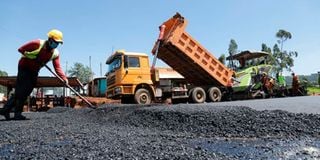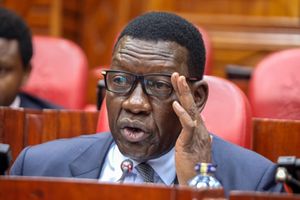
Construction works by Kenya Rural Roads Authority.
The Treasury plans to ring-fence proceeds of the increased road maintenance levy (RML) rate to clear the hundreds of billions of shillings owed to road contractors.
The RML was controversially increased to Sh25 per litre of petrol and diesel from Sh18 for a similar quantity in July. The levy is collected from motorists at the pump.
Treasury Cabinet Secretary John Mbadi said the Sh7 per litre rise will net an extra Sh30 billion annually, with the amount set to be ring-fenced and used to pay off road contractors who are owed more than Sh650 billion.
“If the Sh7 increase in fuel levy is allowed to continue, we have a strategy to securitise this amount, and use it to pay the pending bills and then go back to funding new works. The Sh7 per litre hike is projected to raise an additional Sh30 billion every year" he said in a brief to Senate on Wednesday.
This is likely to raise eyebrows given that the levy is primarily collected to fund maintenance of roads. Kenya is struggling to allocate billions of shillings to clear the debts owed to road contractors, amid below-par tax collections and mounting debt servicing obligations.
Road construction projects in most parts of the country have stalled over the unpaid bills, hurting job creation given the labour-intensive nature of the sector. The Treasury allocated Sh40 billion to clear pending bills for roads in the financial year that ended June 2023 against bills of Sh162 billion for that year alone, highlighting the cash crunch.
The Sh25 per litre RML came into force in July but it is subject to several suits as lobbies and push to have it scrapped on grounds that it is illegal.
This year’s increase was the biggest margin that the government has adjusted RML since it was gazetted in 1993. The raise was made amid protests and court cases challenging the decision.
The increase in RML forced the government to subsidise a litre of petrol and diesel by Sh3.35 and Sh2.50 respectively to negate the impact of the high levy and contain public outrage over fresh increases in the cost of fuel.
The strengthening of the shilling and high subsidy have been crucial in averting the impact of the high RML charged for every litre of petrol and diesel.
While raising the RML, the government had banked on heavy subsidies of fuel prices to ensure that this effect would not be passed to consumers.
Consumers have since December last year enjoyed drops in the cost of fuel, a trend that ended in August in the wake of the increased RML.
Increment of the RML has been contested at the High Court, on grounds that it was imposed without public participation and also that it unfairly exposed Kenyans to a high cost of living.
The court has yet to issue a final determination on the matter.






